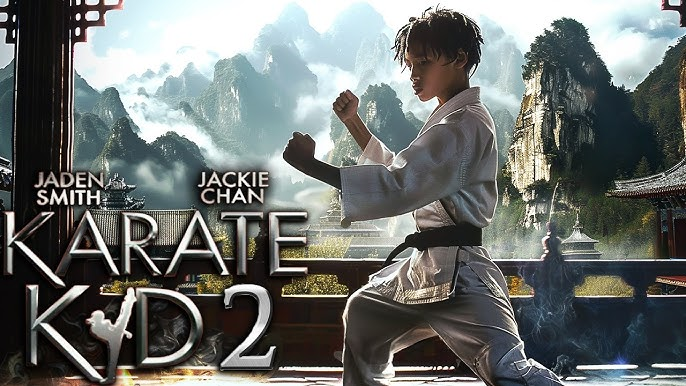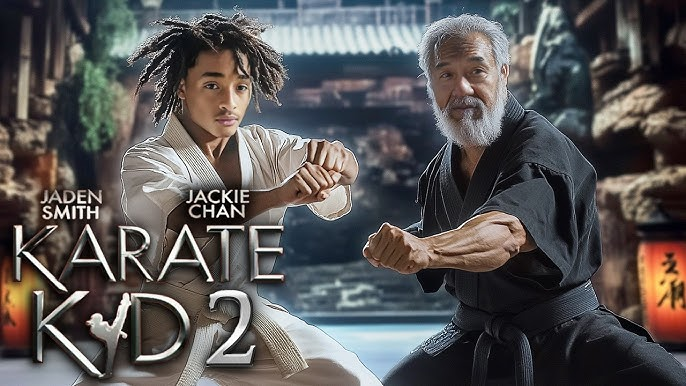The return of The Karate Kid franchise in 2025 is not merely a continuation of a story—it is a rebirth. Karate Kid 2 rises beyond the expectations of a sequel and blossoms into a tale about transformation, courage, and the lifelong pursuit of balance. Where the first film captured the innocence of discovery, this new chapter dares to explore maturity, discipline, and the weight of responsibility.

Jaden Smith returns not as the wide-eyed student we once knew, but as a young man standing at the crossroads of identity. His journey in Okinawa is less about proving strength to others and more about confronting the self within. The film uses this tension—between what we show to the world and what we battle inside—to drive a narrative that feels both timeless and urgent.
At the heart of the story is Jackie Chan’s enduring presence as the mentor. His portrayal is layered with grief, wisdom, and an undercurrent of humor that softens the sternness of training. His methods remain unorthodox, yet each riddle, each task, carries a deeper meaning. Watching Chan guide Jaden is like watching a sculptor slowly reveal a statue hidden within stone. Every scene between them feels like a meditation on patience, tradition, and the quiet power of humility.

Adding to the film’s emotional weight is the introduction of Ip Man’s stoic philosophy, brought to life by a commanding performance that contrasts with Chan’s warmth. Where Chan teaches through metaphor, Ip Man teaches through silence and presence. Together, their teachings shape Jaden into something greater than a fighter—they shape him into a philosopher of motion, a seeker of inner calm amidst outward chaos.
The emotional rhythm of the film is balanced by Awkwafina’s spirited performance. Her character serves as a reminder that even on the hardest paths, humanity shines brightest in laughter. She doesn’t simply provide comic relief; she embodies the spirit of resilience. Through her, the film acknowledges that growth is not only forged in sweat and discipline, but also in the ability to embrace joy along the way.
The choreography is mesmerizing—a dance of tradition and innovation. Every fight is staged not as a spectacle, but as a dialogue between opponents. The kata sequences in Okinawan temples are shot with reverence, every movement echoing centuries of discipline. When fists clash, they are not thrown for destruction, but for understanding. The duels are tests of patience, of courage, of control, reminding the audience that martial arts are not about defeating an enemy, but mastering one’s own spirit.

Visually, the film is a feast of contrasts. California’s golden sunlight frames Jaden’s departure, while Okinawa greets him with a palette of crimson skies and mist-laden mountains. Temples rise like echoes of history, their bells tolling as if in rhythm with his heartbeat. The cinematography lingers on details—the sweat on a brow, the silence before a strike, the calm exhale after a storm. It is through these choices that the film communicates its deeper truth: growth happens in the spaces between battles.
The soundtrack amplifies this journey with precision. The haunting resonance of temple bells merges seamlessly with modern rhythms, creating a soundscape that bridges East and West, past and present. Each training scene is underscored by music that breathes with the characters—swelling in moments of triumph, fading in moments of reflection. By the final act, the score has become not just an accompaniment, but a heartbeat, guiding both characters and audience alike.
What elevates Karate Kid 2 beyond a martial arts drama is its insistence on philosophy. The film reminds us, time and again, that karate is not a weapon for victory, but a path toward self-discovery. Jaden’s transformation is not shown through his punches or kicks, but in his eyes—in the calm that replaces doubt, in the balance that replaces fear. His journey is not about being stronger than others, but about being stronger than yesterday’s self.
As the narrative reaches its climax, we are left with a sense of catharsis. The battles are fierce, but the true resolution comes in silence, in the acknowledgment that mastery is a lifelong path. The final duel does not declare a champion—it declares a student forever in pursuit of harmony. It is a rare thing for a film to end not with a roar, but with a breath, and in that breath lies its power.
Karate Kid 2 (2025) is more than a sequel. It is a meditation, an awakening, and a cinematic journey that lingers long after the credits fade. It does not simply ask the audience to watch—it asks them to reflect. And in that reflection, it earns its place as not just a continuation of a beloved story, but as a timeless lesson: true victory is not over others, but over the self.




